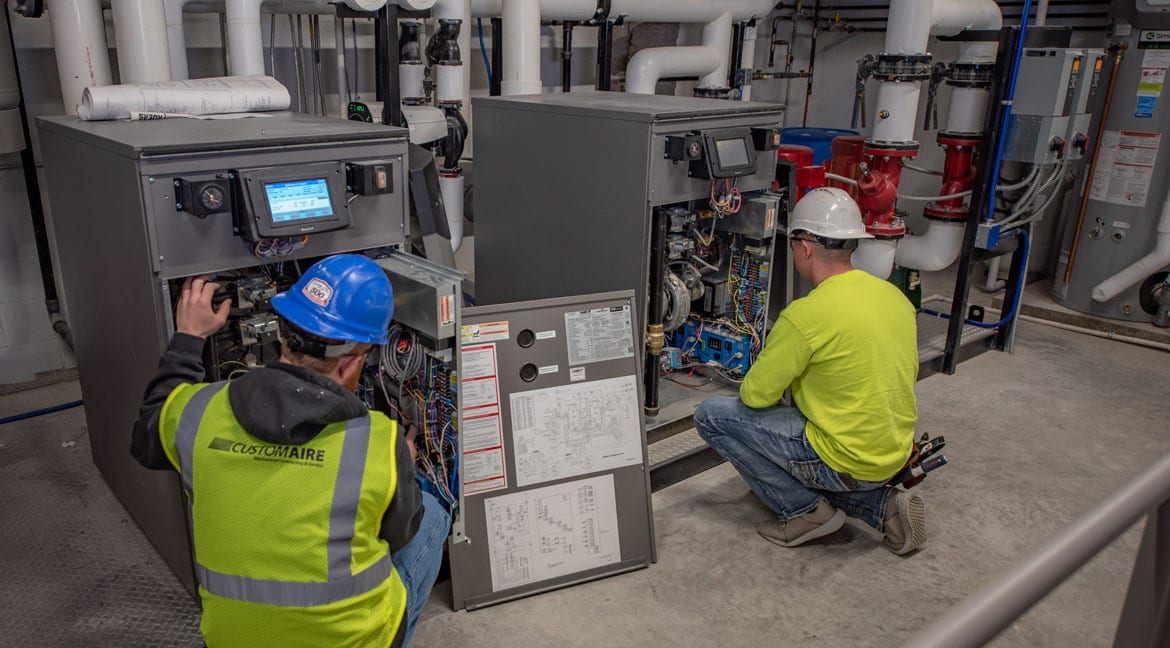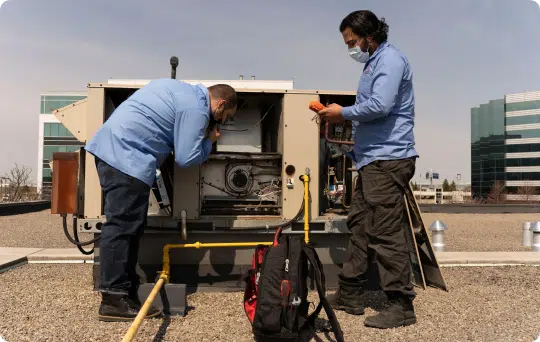Prevent Costly Repairs with Scheduled heat pump service
Prevent Costly Repairs with Scheduled heat pump service
Blog Article
Exactly How a Heatpump and Furnace Interact to Optimize Your Home's Heating Effectiveness
Understanding just how a heatpump and heating system interact is important for homeowners looking for efficient heating remedies. Each system has its strengths, offering a balanced strategy to home comfort. The heatpump masters moderate temperatures, while the heating system provides rapid heat during severe cold. This harmony not only decreases power prices however additionally enhances the life expectancy of both devices. What aspects affect this partnership, and exactly how can property owners optimize their advantages?
Understanding Heat Pumps: Just How They Work
Although many individuals might be not familiar with their inner operations, heatpump play an essential duty in contemporary heater. These gadgets operate by transferring warmth from one area to an additional, utilizing the concepts of thermodynamics. In cooler months, a heat pump removes heat from the outside air, ground, or water, and transfers it inside to warm up the home. On the other hand, throughout warmer months, it can turn around the procedure, acting as an a/c unit by eliminating heat from inside to the outside.Heat pumps include an evaporator, condenser, development, and compressor valve. The cooling agent within the system soaks up warm as it vaporizes at reduced temperature levels and pressures. The compressor after that increases the pressure and temperature of the cooling agent, permitting it to release heat as it condenses. This efficient procedure can significantly lower power intake compared to typical heating approaches, making warm pumps a lasting choice for climate control in homes.
The Role of Furnaces in Home Heating
Heating systems play a crucial role in home heating by providing a trustworthy resource of heat throughout the chillier months. They operate by producing warm through burning or electric resistance, distributing it throughout the home via air ducts or glowing systems. The effectiveness of a heater is often gauged by its Yearly Fuel Usage Efficiency (AFUE) ranking, which suggests how properly the device converts fuel right into heat.Furnaces can use various power sources, including gas, lp, oil, or electricity, allowing homeowners to pick the most suitable option for their requirements. Unlike heat pumps, which might have a hard time in severe chilly, heating systems preserve consistent efficiency, making sure that interior temperatures continue to be comfy despite outdoor conditions. In addition, modern-day heating systems typically come equipped with sophisticated modern technology, such as variable-speed blowers and wise thermostats, enhancing their effectiveness and responsiveness. This adaptability makes heaters a crucial part in all-encompassing home heating approaches.

Benefits of Using Both Systems With Each Other
Combining the strengths of both furnaces and heat pumps can bring about a more efficient and effective home heating remedy. Using both systems enables homeowners to capitalize on the heatpump's power performance during milder temperature levels while relying on the heater for more severe cold problems. This dual approach can significantly lower power expenses, as heatpump eat much less electricity than typical heating approaches when temperatures are moderate.Additionally, using both systems with each other can improve comfort degrees in the home. Heat pumps can provide consistent, also heating, while heating systems can rapidly raise ambient temperatures when required. Moreover, the assimilation of both systems can prolong the lifespan of devices by reducing deterioration on each unit, as they share the work. Inevitably, property owners can delight in a well balanced, cost-efficient heating remedy that readjusts effortlessly to varying climate conditions, making sure a cozy and inviting home throughout the cold weather.
Just How Warmth Pumps and Furnaces Complement Each Other
They develop a complementary heating system that makes best use of efficiency and comfort when house owners integrate warm pumps and heaters. Warmth pumps run by moving heat from the outdoors air or ground, making them extremely reliable in modest climates. They succeed throughout milder temperatures, offering affordable home heating. On the other hand, heaters create warmth through burning or electrical resistance, delivering strong, prompt heat throughout extreme cold conditions.The combination of these 2 systems permits dynamic changes based on temperature level changes. Throughout warmer months or milder winter days, the heat pump can take the lead, preserving power and minimizing costs. As temperature levels decrease, the heating system can flawlessly engage, making sure consistent warmth throughout the home. This synergy not just optimizes energy use however additionally improves the lifespan of both systems, as each device operates within its perfect efficiency range. With each other, they develop a well balanced environment that adjusts to varying environment needs.
Enhancing Efficiency: Tips for Homeowners
House owners can enhance their heating performance through a number of useful techniques. Establishing a normal maintenance timetable, incorporating clever thermostat innovation, and carrying out effective insulation and securing options are crucial actions. These actions not just enhance convenience yet additionally decrease power expenses.
Regular Maintenance Arrange
To ensure optimal home heating efficiency, developing a routine maintenance schedule is necessary for any kind of home. Home owners need to focus on routine assessments of both heatpump and heating systems to establish peak efficiency. This includes transforming air filters each to 3 months, as clogged up filters can greatly reduce performance. Furthermore, scheduling expert maintenance at least yearly allows technicians to identify and deal with potential issues prior to they rise. Home owners must also cleanse the heatpump's outdoor device to prevent debris buildup that can hinder airflow. By sticking to a regular upkeep routine, homeowners not only improve their home heating systems' performance but also extend their lifespan, browse around this site resulting in better convenience and reduced power expenses throughout the cooler months.
Smart Thermostat Assimilation
Incorporating a wise thermostat into a home heating unit can significantly improve power efficiency, particularly as it enables for precise control over temperature level settings. These devices can learn the homeowner's timetable and preferences, instantly readjusting the temperature to enhance comfort while reducing energy usage. They can reduce heating during times when the home is unoccupied, minimizing unnecessary usage. Lots of wise thermostats also offer real-time power usage information, allowing home owners to make educated choices about their heating practices. Additionally, remote accessibility through smart device apps enables users to adjust setups from anywhere, guaranteeing the home is cozy upon return. Overall, wise thermostat assimilation not only improves convenience but substantially contributes to power savings and effectiveness.
Insulation and Sealing Solutions
Smart thermostats play a critical duty in energy performance, yet their efficiency can be considerably boosted by appropriate insulation and sealing services. Property owners must prioritize shielding wall surfaces, attics, and floors to reduce warmth loss. High-quality insulation materials, such as spray foam or fiberglass, can substantially improve thermal resistance. Furthermore, securing gaps around home windows, doors, and air ducts prevents cold air infiltration and warm escape. Weatherstripping and caulking are efficient techniques for addressing these leaks - furnace replacement. Normal inspections for air leakages, in addition to the use of blower door tests, can assist determine trouble areas. By spending in insulation and securing, home owners can optimize the efficiency of their heating unit, ultimately leading to reduced power intake and reduced utility expenses
Typical Myths Regarding Warmth Pumps and Furnaces
What misunderstandings surround heat pumps and furnaces? Lots of individuals incorrectly believe that warm pumps are ineffective in cooler environments. In truth, modern-day warm pumps are created to run effectively also in reduced temperatures, supplying trusted heating throughout wintertime. Another common myth is that heating systems are constantly more efficient than heatpump. Nevertheless, this depends upon the certain power sources and performance scores of the devices in concern. Some may likewise think that using both systems concurrently is unnecessary, yet as a matter of fact, this combination can maximize home heating performance, specifically throughout severe weather. In addition, individuals usually assume that warmth pumps require continuous upkeep, when in reality, they have comparable upkeep needs to traditional heating unit. By disproving these misconceptions, homeowners can make even more informed decisions concerning their heating choices, inevitably leading to enhanced comfort and energy performance in their homes.
Maintenance Factors To Consider for Combined Solutions

Regularly Asked Inquiries
Can Heat Pumps Work Properly in Incredibly Cold Climates?
Warm pumps can battle in exceptionally chilly environments as a result of decreased performance and heat removal limitations. Innovations in technology have actually led to versions developed for better performance in such conditions, enhancing their viability in severe environments.
For How Long Do Warm Pumps and Furnaces Typically Last?
Warm pumps generally last 15 to twenty years, while heating systems have a life expectancy of 15 to thirty years. Routine upkeep can expand their long life, ensuring reliable procedure and reducing the need for early substitutes.

What Is the Ordinary Cost of Putting Up Both Systems?
The typical price of installing both a heatpump and a furnace typically varies in between $5,000 to $10,000 - furnace replacement. Elements affecting this cost include system dimension, installation intricacy, and regional labor prices
Exist Tax Motivations for Utilizing Energy-Efficient Home Heating Systems?
Lots of property owners make inquiries regarding tax obligation rewards for energy-efficient furnace. Numerous federal and state programs commonly supply rebates or credit ratings, urging the fostering of sustainable modern technologies to reduce energy consumption and promote environmental responsibility.
How Do I Choose the Right Size Heatpump and Furnace?
Choosing the right dimension heatpump and heating system entails calculating the home's square video footage, thinking about insulation high quality, and evaluating neighborhood climate. Consulting a professional can ensure perfect system performance and energy efficiency based upon details demands. heat pump replacement ooltewah tn. Recognizing just how a heat pump and heater work with each other is important for property owners seeking reliable home heating services. In colder months, a heat pump removes heat from the outdoors air, ground, or water, and transfers it indoors to warm up the you can find out more living space. When homeowners incorporate heat pumps and furnaces, they create a complementary heating system that optimizes efficiency and convenience. Warm pumps run by transferring heat from the outside air or ground, making them extremely effective in moderate climates. Warmth pumps can have a hard time in very chilly climates due to lowered efficiency and heat extraction limitations
Report this page